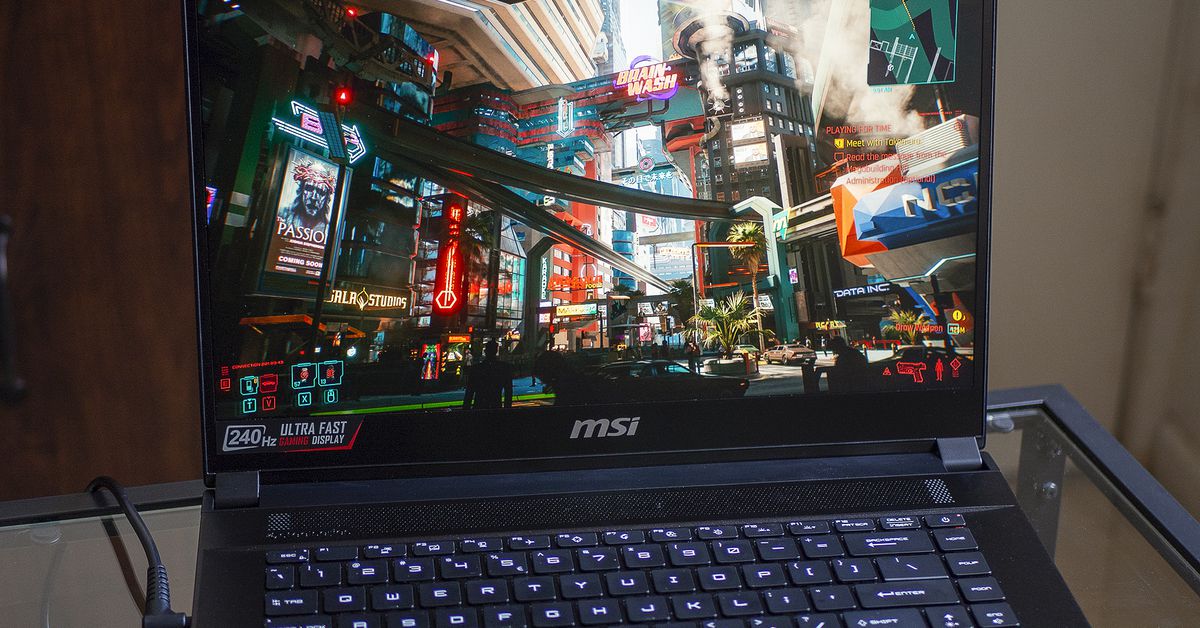Nvidia is making buying a gaming laptop more confusing
Source: The Verge added 26th Jan 2021Gaming laptops that have Nvidia’s powerful RTX 30-series graphics chips inside are now shipping. I have a first look at MSI’s 2021 GS66 Stealth with the RTX 3080, and my colleague Monica Chin published two reviews for launch day: the Asus ROG Flow X13 (with its detachable RTX 3080 eGPU) and the MSI GP66 Leopard with the RTX 3070.
We discovered something strange: an RTX 3070 can now be faster than an RTX 3080 in some cases. We saw this first-hand in a few benchmark runs, where the RTX 3070 in the GP77 Leopard slightly surpassed the RTX 3080 in the GS66 Stealth. It wasn’t a blowout, just a few odd frames per second more in the benchmarks built into games like Horizon: Zero Dawn, Red Dead Redemption 2, and Shadow of the Tomb Raider. But this shouldn’t be happening, right?
This sounds like a huge controversy, but the explanation is nothing new. It’s just become something shadier than it ever needed to be. Nvidia is no longer adding “Max-Q” labels to the weaker, more power-efficient variants of its laptop-grade GPUs, and so you can no longer easily tell if you’re getting a full-fat GPU.
The RTX 3080 in the GS66 Stealth is actually a Max-Q variant with a boost clock of 1,245MHz and a maximum wattage of 95 watts, which is about as weak as an RTX 3080 can get, according to Nvidia’s spec sheets. But customers probably wouldn’t know this by looking at this laptop’s box, MSI’s site, or the numerous retailer sites selling this model. The GP66 Leopard, on the other hand, is using an RTX 3070 that has a higher clock speed and more wattage than the norm, which explains why it was able to pull ahead a few times during our testing.
As NotebookCheck explains, there’s a wide array of wattages each RTX 30-series laptop chip can be set to — but it depends on what kind of laptop the manufacturer wants to sell.
Thinner, lighter gaming laptops tend to use dialed-back Max-Q versions of Nvidia’s graphics chips for better efficiency (indicated as GeForce RTX 2070 Max-Q in the past, for instance), while others use ones that don’t have the Max-Q branding and thus can be trusted to deliver better performance that’s more akin to the desktop versions of the GPU. Now, Nvidia is letting manufacturers hide which one they’re using in a laptop. It lets companies treat Nvidia’s mobile graphics cards on a spec sheet as if they all have consistent performance across all devices, but that’s far from being true.
This lack of transparency is the key difference between how these RTX 30-series graphics chips are being marketed versus previous generations that utilized Max-Q chips, and it may lead to a lot of confused people. Nvidia also doesn’t require manufacturers that use Max-Q graphics chips to have Max-Q stickers on the laptop, which it has done previously.
Naturally, MSI isn’t the only company already taking advantage of this. The Asus TUF Dash 15 and Gigabyte Aorus 15G that I’m testing each claim to have the RTX 3070, but each omits the crucial info that you’re getting the Max-Q variant of the chip. Like MSI’s laptop, you won’t find a detailed breakdown of the GPU’s boost clock speed or wattage requirements on either box or on retail listings.
That’s crucial info to communicate to people, as they all but confirm whether you’re getting a slower Max-Q variant or a faster standard part.
Photo by Cameron Faulkner / The Verge
Why would Nvidia make this change, knowing most average consumers will fall for it? When I asked, a spokesperson told The Verge that it “strongly encourage[s] OEMs to list clocks and other technologies a laptop supports, including Advanced Optimus, Dynamic Boost 2, and more.” Judging by manufacturer websites so far, that “encouragement” doesn’t seem to be working.
Nvidia also says the Nvidia Control Panel app, which is accessible only after you’ve paid for and set up one of these laptops, now provides more spec info than before. Not very helpful.
When I pressed Nvidia on whether it’d work to make these details more transparent to customers when they’re researching which laptop to buy, a spokesperson said the company is “reviewing additional ways to give consumers more insight prior to purchase.” It seems like a simple way of going about this would be to keep a running list of each model with detailed specs, like Nvidia does with G-Sync-compatible monitors.
There’s always a degree of uncertainty as to how each laptop is going to perform in the real world. The Max-Q branding, at the very least, helped customers see right away that they were getting a machine with a graphics chip that had a lower clock speed, thus resulting in slightly dialed-back performance than you’d get from the full-fat chip. Now, you’ll either have to read comparison reviews or hope that Nvidia reverses its policy that lets manufacturers keep people in the dark.
We’ll update this post if and when Nvidia shares its plans to improve transparency for customers.
brands: AORUS Asus Boost Built Crucial First Gigabyte It Key longer MAX Mobile MSI New NVIDIA One other RTX simple Stealth Versus media: 'The Verge' keywords: App Games Gaming laptop Mobile
Related posts
Notice: Undefined variable: all_related in /var/www/vhosts/rondea.com/httpdocs/wp-content/themes/rondea-2-0/single-article.php on line 88
Notice: Undefined variable: all_related in /var/www/vhosts/rondea.com/httpdocs/wp-content/themes/rondea-2-0/single-article.php on line 88
Related Products
Notice: Undefined variable: all_related in /var/www/vhosts/rondea.com/httpdocs/wp-content/themes/rondea-2-0/single-article.php on line 91
Warning: Invalid argument supplied for foreach() in /var/www/vhosts/rondea.com/httpdocs/wp-content/themes/rondea-2-0/single-article.php on line 91
